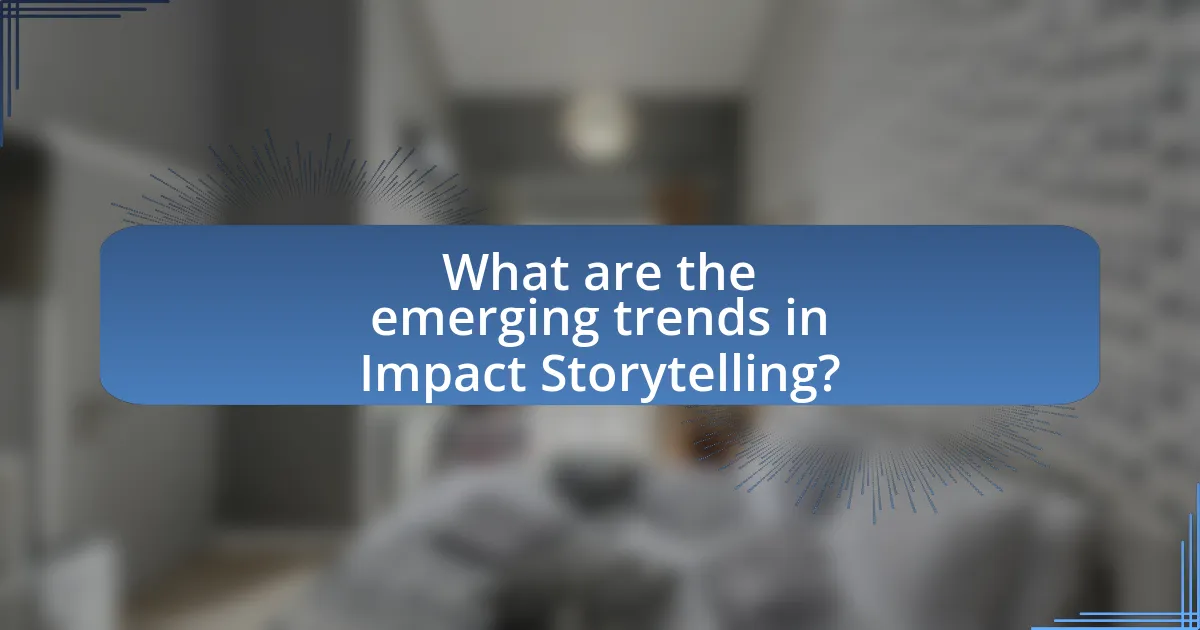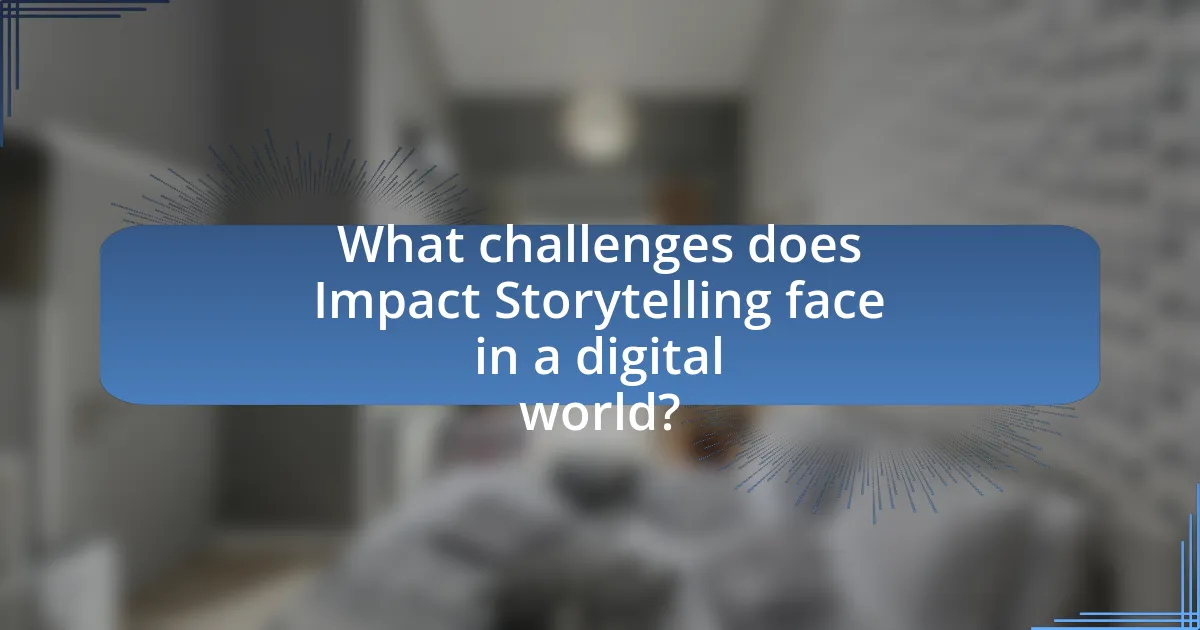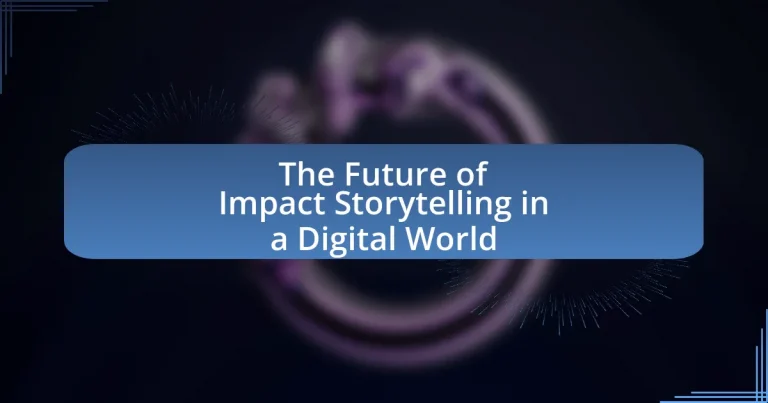The article focuses on the future of impact storytelling in a digital world, emphasizing how digital platforms and technologies enhance narrative engagement and inspire social change. It explores the transformation of storytelling through immersive experiences, interactive elements, and the use of multimedia, highlighting key components such as narrative structure and audience engagement. Additionally, the article addresses the importance of authenticity, the challenges posed by misinformation, and the ethical considerations involved in digital storytelling. Emerging trends, including the integration of artificial intelligence and user-generated content, are also discussed, along with best practices for measuring impact and improving audience retention.

What is Impact Storytelling in a Digital World?
Impact storytelling in a digital world refers to the practice of using digital platforms and technologies to convey narratives that inspire social change and engage audiences emotionally. This approach leverages multimedia elements such as videos, social media, and interactive content to enhance the storytelling experience, making it more relatable and impactful. Research indicates that stories told through digital mediums can increase audience retention and emotional connection, with studies showing that narratives can lead to a 22 times increase in recall compared to facts alone.
How has digital technology transformed storytelling?
Digital technology has transformed storytelling by enabling interactive and immersive experiences that engage audiences in unprecedented ways. Through platforms like virtual reality, augmented reality, and interactive media, storytellers can create environments where users actively participate in the narrative, enhancing emotional connection and engagement. For instance, the use of VR in storytelling allows users to experience a story from multiple perspectives, as seen in projects like “The Invisible Man,” which immerses viewers in the protagonist’s world. Additionally, digital platforms facilitate global distribution, allowing diverse voices and stories to reach wider audiences, exemplified by the success of web series and streaming platforms that showcase international narratives. This shift not only democratizes storytelling but also fosters a more inclusive representation of cultures and experiences.
What are the key elements of digital storytelling?
The key elements of digital storytelling include narrative structure, multimedia elements, interactivity, and audience engagement. Narrative structure provides a coherent storyline that guides the audience through the content, while multimedia elements such as images, videos, and audio enhance the storytelling experience by appealing to various senses. Interactivity allows users to engage with the story, making choices that can influence the outcome, which fosters a deeper connection. Audience engagement is crucial, as it involves understanding the target audience’s preferences and tailoring the story to resonate with them. These elements collectively create a compelling digital narrative that can effectively convey messages and evoke emotions.
How do digital platforms enhance narrative engagement?
Digital platforms enhance narrative engagement by providing interactive and immersive experiences that allow users to participate in storytelling. These platforms utilize multimedia elements such as videos, animations, and user-generated content, which increase emotional connection and investment in the narrative. For instance, research shows that interactive storytelling can lead to higher retention rates and deeper emotional responses compared to traditional storytelling methods. A study published in the Journal of Interactive Media found that users who engaged with interactive narratives reported a 30% increase in emotional engagement compared to those who consumed linear stories. This evidence supports the assertion that digital platforms significantly enhance narrative engagement through their unique capabilities.
Why is impact storytelling important in today’s society?
Impact storytelling is important in today’s society because it effectively communicates complex social issues and inspires action. This form of storytelling engages audiences emotionally, making them more likely to empathize with and understand the challenges faced by others. Research indicates that narratives can significantly influence public perception and behavior; for example, a study published in the journal “Science” found that stories can change attitudes and beliefs more effectively than statistics alone. By harnessing the power of storytelling, organizations and individuals can drive social change, raise awareness, and mobilize communities around critical issues.
What role does storytelling play in social change?
Storytelling plays a crucial role in social change by effectively conveying messages that inspire action and foster empathy. Through narratives, individuals and communities can share their experiences, highlighting social injustices and mobilizing support for change. For instance, the storytelling campaign “Humans of New York” has raised awareness about various social issues, leading to significant fundraising efforts for marginalized individuals. This demonstrates that storytelling not only informs but also engages audiences emotionally, prompting them to participate in social movements and advocate for policy changes.
How can stories influence public perception and behavior?
Stories can significantly influence public perception and behavior by shaping emotional connections and providing relatable contexts. When narratives resonate with individuals, they can alter beliefs and motivate actions, as evidenced by research indicating that storytelling can enhance empathy and understanding. For instance, a study published in the journal “Psychological Science” found that narratives can lead to increased prosocial behavior, demonstrating how stories can effectively change attitudes and encourage community engagement. This illustrates that well-crafted stories not only convey information but also have the power to transform societal norms and individual actions.

What are the emerging trends in Impact Storytelling?
Emerging trends in impact storytelling include the use of immersive technologies, such as virtual reality (VR) and augmented reality (AR), which enhance audience engagement by providing experiential narratives. Additionally, data-driven storytelling is gaining traction, where analytics inform narrative structures to resonate more effectively with target audiences. The rise of social media platforms has also shifted storytelling towards shorter, more impactful formats that prioritize emotional connection and shareability. Furthermore, collaborative storytelling, involving diverse voices and perspectives, is becoming increasingly important to reflect a broader range of experiences and foster inclusivity. These trends are supported by research indicating that immersive and data-informed narratives significantly increase audience retention and emotional engagement, making them effective tools for social change.
How are social media platforms shaping storytelling techniques?
Social media platforms are shaping storytelling techniques by enabling real-time engagement and interactive narratives. These platforms allow creators to share stories through various formats such as short videos, live streams, and user-generated content, fostering a more participatory approach to storytelling. For instance, Instagram Stories and TikTok’s short-form videos encourage concise, visually-driven narratives that capture audience attention quickly. Research indicates that 54% of consumers prefer to see video content from brands, highlighting the effectiveness of these formats in storytelling. Additionally, social media algorithms prioritize content that generates engagement, pushing storytellers to adapt their techniques to be more relatable and shareable, thus influencing the overall narrative style in digital storytelling.
What are the most effective formats for storytelling on social media?
The most effective formats for storytelling on social media include video, images, and live streaming. Video content, particularly short-form videos like those on TikTok and Instagram Reels, captures attention quickly and can convey complex narratives in a concise manner. According to a report by HubSpot, 54% of consumers prefer video content from brands, highlighting its effectiveness in engaging audiences. Images, especially those that tell a story or evoke emotion, are also powerful; posts with images receive 650% higher engagement than text-only posts, as noted by the Social Media Examiner. Live streaming allows for real-time interaction and authenticity, fostering a deeper connection with the audience, which is supported by the fact that 80% of consumers would rather watch a live video from a brand than read a blog post, according to Livestream. These formats leverage visual and interactive elements to enhance storytelling, making them particularly effective on social media platforms.
How do user-generated content and community engagement enhance stories?
User-generated content and community engagement enhance stories by providing diverse perspectives and fostering a sense of belonging among participants. This inclusion of various voices enriches narratives, making them more relatable and authentic. For instance, platforms like Instagram and TikTok showcase user-generated content that often resonates more with audiences than traditional media, as evidenced by a study from the Pew Research Center, which found that 72% of teens feel more connected to their peers through shared content. Additionally, community engagement encourages collaboration, leading to stories that reflect collective experiences and values, thereby increasing emotional impact and audience investment.
What technologies are driving the future of storytelling?
Artificial intelligence, virtual reality, augmented reality, and blockchain technology are driving the future of storytelling. These technologies enhance narrative experiences by enabling personalized content, immersive environments, and secure distribution. For instance, AI algorithms analyze user preferences to tailor stories, while virtual and augmented reality create interactive worlds that engage audiences on a deeper level. Additionally, blockchain ensures transparency and ownership of digital content, fostering trust between creators and consumers. The integration of these technologies is reshaping how stories are told and experienced in the digital landscape.
How is virtual reality changing the storytelling landscape?
Virtual reality is transforming the storytelling landscape by enabling immersive experiences that engage audiences on a deeper emotional level. This technology allows users to step into narratives, interact with characters, and influence outcomes, creating a sense of presence that traditional media cannot achieve. For instance, studies have shown that VR experiences can increase empathy and understanding, as seen in projects like “The Displaced,” which places viewers in the shoes of refugees. This shift towards experiential storytelling is reshaping how narratives are crafted and consumed, making them more participatory and impactful.
What role does artificial intelligence play in crafting narratives?
Artificial intelligence plays a significant role in crafting narratives by enhancing creativity, personalizing content, and automating storytelling processes. AI algorithms analyze vast amounts of data to identify patterns and themes, enabling creators to generate compelling storylines that resonate with audiences. For instance, tools like OpenAI’s GPT-3 can produce coherent and contextually relevant text, allowing writers to explore new narrative possibilities efficiently. Additionally, AI can tailor stories to individual preferences, improving engagement by adapting narratives based on user behavior and feedback. This capability is supported by research indicating that personalized content can increase audience retention and satisfaction, demonstrating AI’s effectiveness in narrative development.

What challenges does Impact Storytelling face in a digital world?
Impact storytelling faces several challenges in a digital world, primarily including information overload, audience fragmentation, and the need for authenticity. Information overload occurs as audiences are bombarded with vast amounts of content daily, making it difficult for impactful stories to stand out. Audience fragmentation complicates this further, as diverse platforms attract different demographics, requiring tailored approaches to engage effectively. Additionally, the demand for authenticity has increased; audiences are more discerning and seek genuine narratives that resonate with their values, making it essential for storytellers to maintain credibility while conveying their messages. These challenges necessitate innovative strategies to ensure that impact storytelling remains effective and relevant in a rapidly evolving digital landscape.
How do misinformation and digital noise affect storytelling?
Misinformation and digital noise significantly distort storytelling by undermining the credibility of narratives and overwhelming audiences with irrelevant content. This distortion occurs as audiences struggle to differentiate between factual information and misleading claims, leading to confusion and skepticism towards authentic stories. Research indicates that 59% of Americans believe fabricated news stories cause confusion about the basic facts of current events, which directly impacts how stories are received and interpreted. Consequently, storytellers must navigate this landscape by ensuring clarity and accuracy in their narratives to maintain audience trust and engagement.
What strategies can storytellers use to combat misinformation?
Storytellers can combat misinformation by employing fact-checking, narrative clarity, and audience engagement strategies. Fact-checking involves verifying information before dissemination, which helps ensure accuracy and builds credibility. For instance, organizations like Snopes and FactCheck.org provide resources that storytellers can utilize to confirm the validity of claims. Narrative clarity focuses on presenting information in a straightforward manner, avoiding jargon, and emphasizing key facts to enhance understanding. Engaging the audience through interactive storytelling techniques, such as social media polls or discussions, fosters critical thinking and encourages individuals to question misleading narratives. These strategies collectively empower storytellers to effectively counter misinformation in a digital landscape.
How can authenticity be maintained in digital narratives?
Authenticity in digital narratives can be maintained through transparency, consistent voice, and audience engagement. Transparency involves openly sharing the sources of information and the motivations behind the narrative, which builds trust with the audience. A consistent voice ensures that the narrative aligns with the values and beliefs of the storyteller, reinforcing credibility. Engaging the audience through interactive elements, such as feedback loops and community involvement, fosters a sense of ownership and connection to the narrative. Research indicates that narratives perceived as authentic lead to higher audience engagement and trust, as demonstrated in studies on digital storytelling effectiveness.
What ethical considerations are involved in digital storytelling?
Ethical considerations in digital storytelling include issues of consent, representation, and the potential for misinformation. Consent is crucial, as storytellers must ensure that individuals featured in narratives have given permission for their stories to be shared, particularly in sensitive contexts. Representation involves accurately portraying diverse voices and experiences, avoiding stereotypes, and ensuring that marginalized groups are not exploited for narrative purposes. The risk of misinformation arises when stories are manipulated or presented without context, leading to misinterpretation or harm. These considerations are essential to maintain integrity and respect in the storytelling process.
How can storytellers ensure they represent diverse voices?
Storytellers can ensure they represent diverse voices by actively engaging with and including individuals from various backgrounds in the storytelling process. This approach involves conducting thorough research to understand different cultural perspectives and experiences, as well as collaborating with diverse creators and consultants who can provide authentic insights. For instance, a study by the Annenberg Inclusion Initiative found that films with diverse casts and crews tend to perform better at the box office, highlighting the importance of representation in storytelling. By prioritizing inclusivity and authenticity, storytellers can create narratives that resonate with a broader audience and reflect the richness of human experiences.
What are the implications of data privacy in storytelling?
Data privacy significantly impacts storytelling by influencing how personal data is collected, used, and shared in narratives. The implications include the necessity for transparency in data usage, as audiences increasingly demand ethical handling of their information. For instance, the General Data Protection Regulation (GDPR) in Europe mandates that organizations obtain explicit consent from individuals before using their data, which affects how storytellers can engage with their audience. Additionally, breaches of data privacy can lead to loss of trust, as seen in cases like the Cambridge Analytica scandal, where misuse of personal data led to public outrage and a reevaluation of data practices in storytelling. Thus, data privacy shapes the ethical landscape of storytelling, requiring creators to balance narrative engagement with respect for individual privacy rights.
What best practices can enhance Impact Storytelling in a digital context?
Best practices that can enhance Impact Storytelling in a digital context include utilizing data-driven narratives, engaging visuals, and interactive elements. Data-driven narratives provide concrete evidence that supports the story, making it more credible and relatable; for instance, incorporating statistics or case studies can illustrate the impact effectively. Engaging visuals, such as infographics or videos, capture attention and convey complex information quickly, as studies show that visuals can increase retention rates by up to 65%. Interactive elements, like polls or quizzes, foster audience participation, which can lead to a deeper emotional connection with the story. These practices collectively create a more compelling and memorable storytelling experience in the digital realm.
How can storytellers effectively measure their impact?
Storytellers can effectively measure their impact by utilizing quantitative metrics such as audience engagement, reach, and feedback. For instance, analyzing social media shares, comments, and likes provides concrete data on how well a story resonates with its audience. Additionally, surveys and interviews can gather qualitative insights, revealing emotional responses and behavioral changes prompted by the storytelling. Research indicates that 70% of consumers are more likely to remember a story than a statistic, highlighting the importance of narrative in measuring impact. By combining these quantitative and qualitative methods, storytellers can gain a comprehensive understanding of their influence.
What techniques can improve audience engagement and retention?
Techniques that can improve audience engagement and retention include personalized content, interactive elements, and storytelling. Personalized content, which tailors messages to individual preferences, has been shown to increase engagement rates by up to 50%, as it resonates more with the audience’s interests. Interactive elements, such as polls and quizzes, encourage active participation, leading to a 70% increase in retention according to studies by the Content Marketing Institute. Additionally, storytelling creates emotional connections, making information more memorable; research indicates that stories are 22 times more memorable than facts alone. These techniques collectively enhance the audience’s experience, fostering deeper connections and sustained interest.


